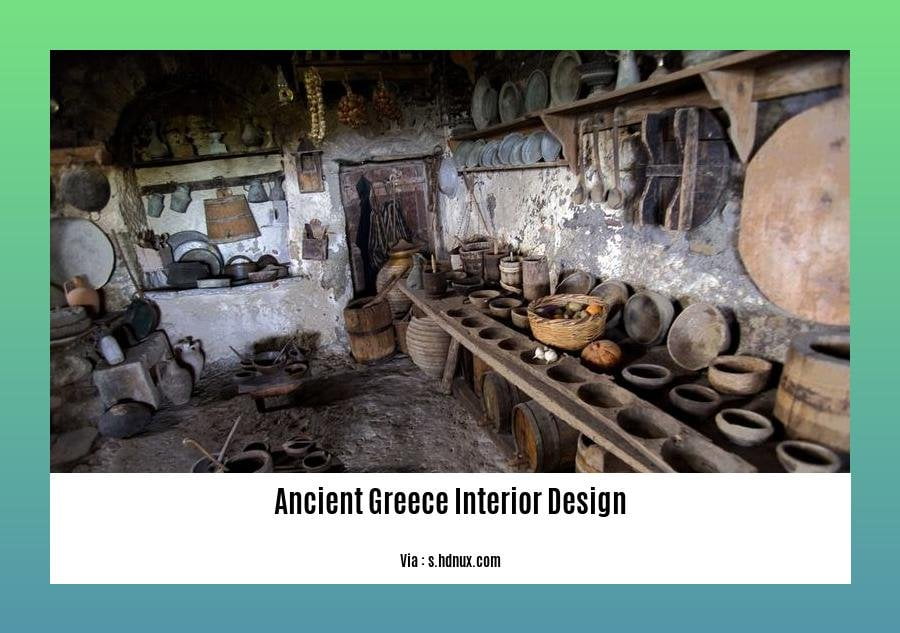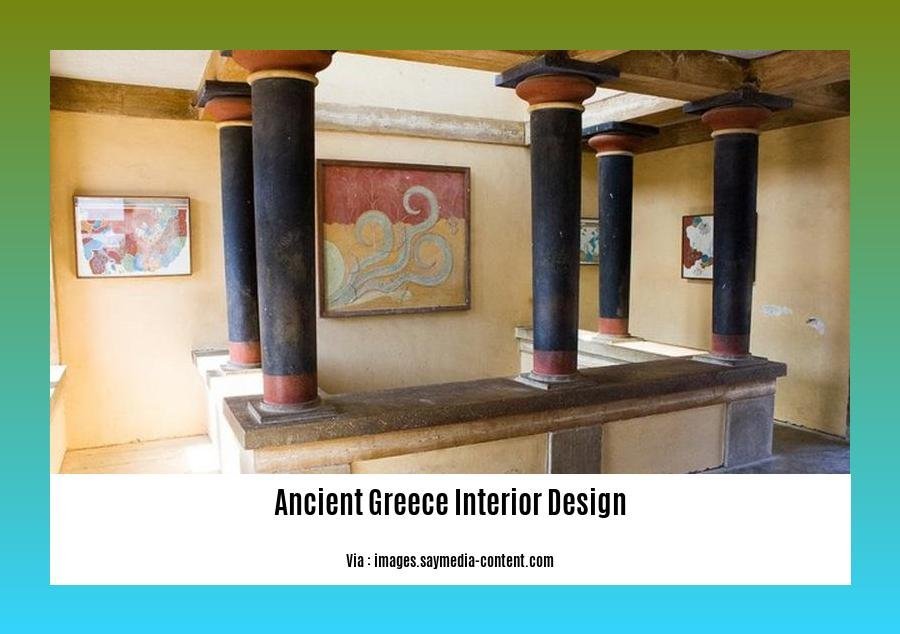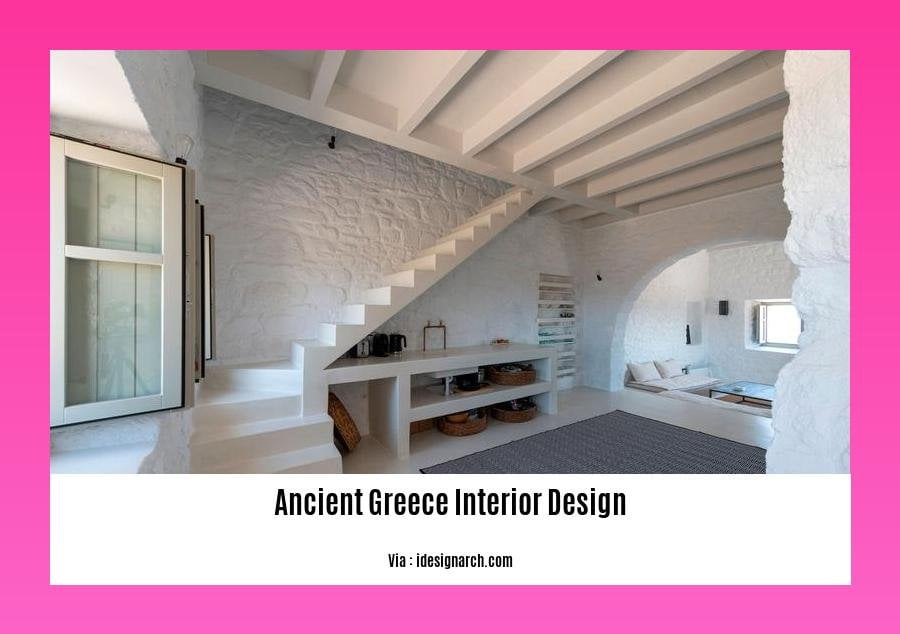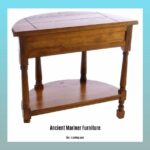Embark on a captivating journey into the realm of ancient Greece interior design in [Unveiling the Timeless Beauty of Ancient Greece Interior Design], where aesthetics and history harmoniously converge. Discover how ancient Greek principles, motifs, and design elements continue to inspire and shape modern interior design, creating spaces that exude elegance, grace, and timeless appeal.
Key Takeaways:
- Ancient Greek interior design incorporates bronze animal legs, gilding, encrusted jewels, and stones.
- Native woods like olive, yew, and cedar are commonly used for furniture pieces.
- The principle of conciseness is embraced, with fewer design elements, furniture, accessories, and color accents.
- Combinations of artificial and natural materials are employed, with a focus on reflecting the surrounding environment.
- White walls and brightly colored wooden windows, shutters, and doors are common features.
- Decorative columns and Greek mythology-inspired motifs and patterns may be present.
- Furniture types are adopted from ancient Egyptians or the Middle East but with unique Greek touches.
- Limited furniture pieces are utilized, emphasizing quality and craftsmanship.
- Arches, Greek-inspired color palettes, and subtle architectural details can incorporate Greek design into modern homes.
Ancient Greece Interior Design: Unparalleled Elegance and Simplicity

Ancient Greece interior design stands as a testament to the enduring allure of classical aesthetics. Its principles of simplicity, elegance, and harmony have captivated designers and homeowners for centuries. Let’s delve into the world of ancient Greece interior design, uncovering its rich history, key elements, and enduring relevance.
Elegance and Simplicity: The Hallmarks of Greek Design
Ancient Greece interior design embodies the principles of elegance and simplicity. Greek designers believed in creating spaces that were visually appealing, yet uncluttered. They favored clean lines, minimalist decor, and a restrained use of color. This approach resulted in interiors that were both sophisticated and inviting, fostering a sense of serenity and balance.
Natural Materials and Earthy Tones: A Reflection of the Environment
Ancient Greece interior design heavily utilized natural materials, such as stone, wood, and marble. These materials were not only aesthetically pleasing but also reflected the surrounding environment. The Greeks drew inspiration from their natural surroundings, incorporating elements like olive trees, grapevines, and flowers into their designs. Earthy tones, such as beige, brown, and green, were commonly used to create a warm and harmonious atmosphere.
Furniture: Functional and Aesthetic
Furniture in ancient Greece interior design was both functional and aesthetically pleasing. Pieces were typically made from wood or bronze and featured simple, elegant lines. Seating options included klismos chairs, characterized by their curved backs and splayed legs, and diphroi, long benches with or without backs. Tables were often rectangular or square, with simple legs and plain tops. Beds were typically made of wood and featured mattresses stuffed with straw or wool.
Decorative Elements: Mythological Motifs and Geometric Patterns
Ancient Greece interior design incorporated various decorative elements to enhance the visual appeal of spaces. Murals and mosaics depicting mythological scenes or geometric patterns adorned walls and floors. Sculptures and statues of gods and goddesses were often placed in prominent positions, adding an air of grandeur and reverence to the space.
Integrating Greek Design Principles into Modern Homes
The principles of ancient Greece interior design can be seamlessly integrated into modern homes to create timeless and elegant spaces. Here are a few tips:
- Embrace simplicity and clean lines by opting for minimalist furniture and decor.
- Incorporate natural materials such as wood, stone, and marble to create a warm and inviting atmosphere.
- Use neutral tones as a backdrop and add pops of color through accents and accessories.
- Add Greek-inspired decorative elements, such as columns, pediments, and motifs, to create a cohesive look.
- Experiment with Greek color palettes, featuring shades of blue, green, and ochre, to evoke a Mediterranean feel.
Ancient Greece interior design continues to inspire and captivate with its timeless beauty and elegance. Its principles of simplicity, harmony, and natural materials create spaces that are both aesthetically pleasing and inviting. Whether you’re designing a new home or refreshing an existing space, incorporating elements of ancient Greece interior design can add a touch of classic sophistication and enduring charm.
Uncover the rich history of ancient fishing methods with our comprehensive guide to ancient fishing rods.
Embark on an educational journey through ancient Greece with our engaging lesson plan, specially crafted for educators.
Explore the etymology of ancient Greek words and uncover the profound meaning behind the ancient Greek word for life.
Furniture and Furnishings in Ancient Greek Interiors
Picture yourself transported back to the glorious era of ancient Greece, a world of gods and goddesses, philosophers and artists. Their homes were as divine as their architecture, showcasing remarkable furniture and furnishings that continue to captivate design enthusiasts today.
Key Takeaways:
Functionality and Beauty: Ancient Greek furniture harmoniously blended functionality with elegance, prioritizing comfort and practicality without compromising aesthetics.
Natural Materials: Wood, stone, and bronze were the stars of the show, celebrated for their durability and natural beauty. These materials exuded warmth and authenticity, connecting interiors to the surrounding environment.
Simple Forms: Greek furniture shunned ostentatious ornamentation, instead embracing clean lines and simple forms. This minimalism allowed the inherent beauty of the materials to shine through, creating a sense of order and serenity.
Furniture Types: Stools, couches, chests, small tables, and chairs were the main players in ancient Greek interiors. Each piece served a specific purpose, showcasing the Greeks’ attention to detail and practicality.
Decorative Elements: While decorative elements were used sparingly, they made a powerful impact. Murals, mosaics, sculptures, and statues adorned homes, often depicting scenes from mythology or nature, adding a touch of narrative and visual interest.
From Palaces to Homes: A Journey Through Greek Furniture and Furnishings
Stepping into an ancient Greek home, you’d encounter furniture designed to fulfill various needs. Couches, known as “klines,” were more than just seating; they doubled as sleeping surfaces, covered with soft cushions and textiles. Chests, or “larnakes,” were versatile storage solutions, securing precious belongings and doubling as benches.
Tables came in various shapes and sizes, serving different purposes. Dining tables, often made of wood or stone, were the centerpieces of communal meals. Smaller tables, often with intricate carvings, were used for writing, reading, or displaying decorative items.
Chairs, though less common than stools, were reserved for honored guests or elders. They featured simple designs with curved backs and legs, ensuring comfort during long discussions or gatherings.
A Legacy of Timeless Beauty
The legacy of ancient Greek furniture and furnishings extends far beyond their historical significance. Their timeless designs and emphasis on functionality continue to inspire contemporary interior design. Modern homes can incorporate Greek elements through minimalist furniture, natural materials, and neutral color palettes. Greek-inspired decorative pieces, such as statues or mosaics, add a touch of antiquity and sophistication.
Ancient Greece’s approach to interior design serves as a reminder that beauty and functionality can coexist harmoniously. By drawing inspiration from this rich heritage, we can create living spaces that are both aesthetically pleasing and practical, evoking the essence of ancient Greece in our modern world.
References:
Ancient Greek Interior Design
10 Ways to Incorporate Greek Design into Your Home
Decorative Elements and Motifs

The decorative elements and motifs are what breathes life into ancient Greek interiors, reflecting a profound reverence for nature, mythology, and harmony. Let’s voyage into the rich tapestry of these distinctive designs:
1. Natural Inspirations:
– Drawing from nature’s beauty, ancient Greeks incorporated floral and faunal motifs into their designs. From delicate vines to majestic lions, these elements added a touch of the wild, inviting nature indoors.
– Botanical motifs, such as acanthus leaves and palmettes, were intricately carved on furniture, columns, and friezes, evoking the essence of a flourishing garden.
2. Mythological Scenes:
– Greek mythology, with its captivating tales of gods and heroes, served as a significant source of inspiration for decorative elements.
– Sculptures and paintings adorned walls and ceilings, depicting scenes from these myths, adding a narrative depth to living spaces.
– Mosaics, with their vibrant colors, brought these mythical stories to life on floors and tabletops, creating immersive environments.
3. Geometric Patterns:
– Greek art and architecture were heavily influenced by mathematical principles and geometry.
– Geometric patterns, such as meanders, frets, and guilloches, were commonly found in borders, mosaics, and textiles, adding a sense of order and harmony to spaces.
– These intricate patterns created a visual rhythm that complemented the clean lines and minimalist aesthetic of Greek interiors.
4. Color Palette:
– Ancient Greeks had a refined sense of color, often using bright and vibrant hues to accentuate architectural elements and decorative pieces.
– Blue, the color of the sea and sky, was a popular choice, as was ochre, which evoked the warm tones of the earth.
– White remained the dominant color, reflecting the brilliant Mediterranean light and creating a sense of spaciousness.
5. Architectural Details:
– Columns, with their elegant proportions and intricate capitals, were not just structural elements; they were also decorative focal points.
– Pediments, triangular gables above doorways and windows, often featured sculptures or intricate carvings, adding a touch of drama to entrances and facades.
– Moldings and cornices, with their delicate patterns and subtle curves, provided a refined finish to walls and ceilings.
Key Takeaways:
- Nature served as a primary source of inspiration for decorative elements, from floral motifs to majestic animals.
- Mythological scenes, depicted through sculptures, mosaics, and paintings, added a narrative depth to living spaces.
- Geometric patterns, like meanders and frets, brought order and harmony to interiors.
- Bright colors, such as blue and ochre, were used for accents, while white dominated as the main color.
- Architectural details, such as columns, pediments, and moldings, added visual interest and sophistication.
Sources:
- Ancient Greek Interior Design
- Decorative Elements and Motifs in Ancient Greek Art
Influence of Ancient Greek Interior Design on Later Periods
Hello, there! Welcome to a fascinating journey through time as we explore the enduring influence of ancient Greek interior design on later periods. From the grandeur of ancient temples to the elegance of modern homes, the legacy of Greek aesthetics continues to inspire and shape our living spaces.
Key Takeaways:
Simplicity and Elegance: Ancient Greek interior design was characterized by its emphasis on simplicity, clean lines, and harmonious proportions, influencing later periods to embrace minimalism and understated luxury.
Use of Natural Materials: The Greeks favored natural materials like stone, wood, and marble, which exuded a sense of authenticity and connection to the environment. This appreciation for natural materials has carried forward, shaping the popularity of organic and sustainable design approaches.
Incorporation of Decorative Elements: Greek interiors were adorned with intricate paintings, sculptures, and mosaics depicting mythological scenes and geometric patterns. These decorative elements added visual interest and storytelling to spaces, a practice that continues to influence contemporary interior design.
Open and Airy Spaces: Ancient Greek homes were designed around central courtyards, allowing natural light and ventilation. This emphasis on open and airy spaces has influenced modern architecture, leading to the creation of spacious and well-lit interiors.
Evolution of Greek Design Principles:
The influence of ancient Greek interior design can be traced through various periods, each adding its own unique interpretation.
Hellenistic Period: The Hellenistic period witnessed a fusion of Greek and Eastern influences, resulting in more elaborate and ornate interiors with rich colors and intricate patterns.
Roman Empire: The Romans admired and adopted Greek design principles, incorporating them into their architectural and decorative styles. This led to the development of opulent interiors featuring marble floors, frescoed walls, and mosaic pavements.
Renaissance and Neoclassicism: During the Renaissance and Neoclassical periods, there was a revival of interest in ancient Greek art and architecture. Designers and architects drew inspiration from classical forms, columns, pediments, and decorative motifs, creating interiors that evoked a sense of grandeur and sophistication.
Modern and Contemporary Design: Even in modern and contemporary times, the influence of ancient Greek interior design persists. Elements such as clean lines, neutral color palettes, and the use of natural materials continue to resonate with designers, creating timeless and elegant spaces.
How to Incorporate Greek Design Elements Today:
If you’re drawn to the beauty of ancient Greek interior design, here are some tips for incorporating its elements into your own space:
Embrace Simplicity: Opt for simple and uncluttered interiors, allowing the beauty of natural materials and clean lines to take center stage.
Choose Natural Materials: Incorporate natural materials like wood, stone, and marble into your decor. These materials add a sense of authenticity and warmth to any space.
Add Decorative Touches: Introduce decorative elements inspired by ancient Greek art and mythology. This could include sculptures, paintings, or even mosaic tiles, adding visual interest and personality to your space.
Create Open and Airy Spaces: Design your interiors with an emphasis on open and airy layouts, allowing natural light to flood in. Incorporate elements like large windows, skylights, and open floor plans to achieve this effect.
By incorporating these elements, you can bring the timeless beauty of ancient Greek interior design into your own home, creating a space that exudes elegance, simplicity, and a connection to history.
Sources:
Evolution and Influences: A Journey through the History of Interior Design
Ancient Greek Interior Design: Source of Inspiration for the Designers
FAQ
Q1: What were the main characteristics of ancient Greek interior design?
A1: Ancient Greek interior design emphasized simplicity, proportion, and harmony. Interiors were often decorated with colorful murals, columns, and statues.
Q2: What materials were commonly used in ancient Greek interior design?
A2: Ancient Greeks used a variety of materials in their interior design, including stone, wood, metal, and leather. Wood was the most common material, and it was used to make a wide variety of furniture, including chairs, stools, tables, and chests.
Q3: What colors were typically used in ancient Greek interior design?
A3: The Greeks used a limited palette of colors in their interior design. The most common colors were white, black, red, yellow, and blue. White was often used for the walls, while black was used for the floors. Red, yellow and blue were used for accents.
Q4: What were some of the common decorative elements used in ancient Greek interior design?
A4: The Greeks used a variety of decorative elements in their homes, including paintings, sculptures, mosaics, and textiles. Greek art often depicted scenes from mythology or everyday life. Sculptures were often used to decorate temples and public buildings, but they could also be found in private homes. Mosaics were used to create intricate floor and wall designs. Textiles were used to make curtains, cushions, and upholstery.
Q5: How can ancient Greek interior design elements be incorporated into modern homes?
A5: There are several ways to incorporate ancient Greek interior design elements into modern homes. Some popular methods include using natural colors and materials, incorporating minimalist decor and open spaces, utilizing mythology and clay ceramics as decorative elements, and incorporating Greek-inspired architecture.
- China II Review: Delicious Food & Speedy Service - April 17, 2025
- Understand Virginia’s Flag: History & Debate - April 17, 2025
- Explore Long Island’s Map: Unique Regions & Insights - April 17, 2025
















